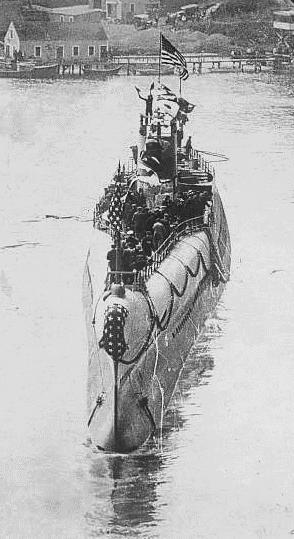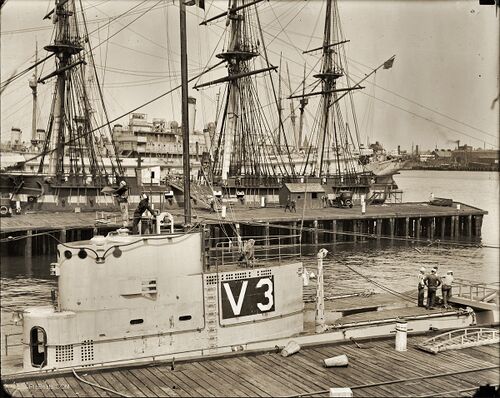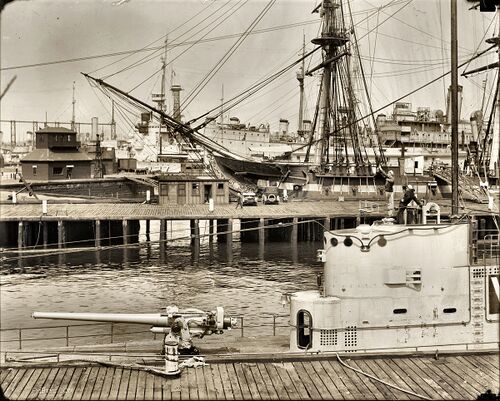V-3: Difference between revisions
Pbcjohnston (talk | contribs) (Added photos) |
Pbcjohnston (talk | contribs) (Updated captions) |
||
| Line 16: | Line 16: | ||
[[File:Bonita boston-1.jpg|left|500px]] | [[File:Bonita boston-1.jpg|left|500px]] | ||
<div style="text-align: justify;"><span style="color:#00008B">The | <div style="text-align: justify;"><span style="color:#00008B">The USS V-3 moored at the Boston Navy Yard in Charlestown, MA., with the USS Constitution, "Old Ironsides" in the background. The date is not known for sure, but is believed to be between May, 1926 and November, 1927. The Signalman on top of the bridge is signaling with semaphore flags, creating the letter "R". He is standing on a watertight housing for a magnetic compass repeater. The windows of the covered pilothouse are visible on the front edge of the bridge fairwater, just forward of a watertight grommet for radio aerial wires. The open hatch above the "V3" leads to the aft engine room. Aft of the conning tower fairwater is the port small boat kingpost, the boom is laying at deck level. The men are standing on top the port boat storage decking. | ||
V-3's commanding officer at this time was LCDR Charles A. Lockwood, Jr., later to rise in rank to the rank of Vice Admiral with command of the Submarine Force, Pacific Fleet (COMSUBPAC). He was instrumental in developing the leadership and strategy in the highly successful submarine war against Japan. | V-3's commanding officer at this time was LCDR Charles A. Lockwood, Jr., later to rise in rank to the rank of Vice Admiral with command of the Submarine Force, Pacific Fleet (COMSUBPAC). He was instrumental in developing the leadership and strategy in the highly successful submarine war against Japan. | ||
| Line 25: | Line 25: | ||
[[File:Bonita boston-2.jpg|left|500px]] | [[File:Bonita boston-2.jpg|left|500px]] | ||
<div style="text-align: justify;"><span style="color:#00008B">Another photo taken shortly after the one above, with the Signalman now signaling the letter "U". The numerous small holes in the side of the fairwater are limber holes. The fairwater is free-flooding and thus the limber holes allow the area to flood and drain as the boat dives or surfaces. The actual conning tower is a medium sized vertical cylinder that houses a periscope station and torpedo firing equipment. It is completely enclosed by the fairwater. Just forward of the conning tower and immediately behind the door-less oval opening is an access trunk that leads to the control room. This trunk is used by the gun crew to access the main deck during a gun action and is likely the path for the ammunition passing train from the magazine below the control room. | |||
There are good details of the 5"/51 caliber Mk 9 gun visible here and in the photo below. This was a large and heavy weapon that fired "semi-fixed" ammunition, meaning that the complete round (projectile + propellent charge) is stored connected together in the magazine, but the two can be easily separated for quicker handling. This would have been a necessity without a powered ammunition hoist. | |||
<small>Boston Public Library/National Archives Photo</small> | |||
[[File:Red bar sub new.jpg]] | |||
[[File:Bonita boston-3.jpg|left|500px]] | [[File:Bonita boston-3.jpg|left|500px]] | ||
<div style="text-align: justify;"><span style="color:#00008B">In the last of the Boston Navy Yard photos, V-3's Signalman is now making the letter "Y" with his flags. In the background behind the Constitution is the white hull of an Omaha-class light cruiser, and the cage mast of a battleship. On the far left, just visible at the edge of the photo is a battleship gun turret, indicating that there are at least two battleships in port. The other ships are unidentified. Unlike today, the Boston Navy Yard was a busy and vibrant place for the USN of the 1920's and a favored port-of-call for warships of all types. | |||
<small>Boston Public Library/National Archives Photo</small> | |||
[[File:Red bar sub new.jpg]] | |||
Revision as of 19:01, 3 July 2023

Photo in the private collection of Ric Hedman.

Photo courtesy of the Milne Special Collections, University of New Hampshire Library, Durham, N.H. Used with permission.

V-3's commanding officer at this time was LCDR Charles A. Lockwood, Jr., later to rise in rank to the rank of Vice Admiral with command of the Submarine Force, Pacific Fleet (COMSUBPAC). He was instrumental in developing the leadership and strategy in the highly successful submarine war against Japan.
Boston Public Library/National Archives Photo

There are good details of the 5"/51 caliber Mk 9 gun visible here and in the photo below. This was a large and heavy weapon that fired "semi-fixed" ammunition, meaning that the complete round (projectile + propellent charge) is stored connected together in the magazine, but the two can be easily separated for quicker handling. This would have been a necessity without a powered ammunition hoist.
Boston Public Library/National Archives Photo

Boston Public Library/National Archives Photo
Page created by:
Ric Hedman & David Johnston
1999 - 2023 - PigBoats.COM©
Mountlake Terrace, WA, Norfolk, VA
webmaster at pigboats dot com
